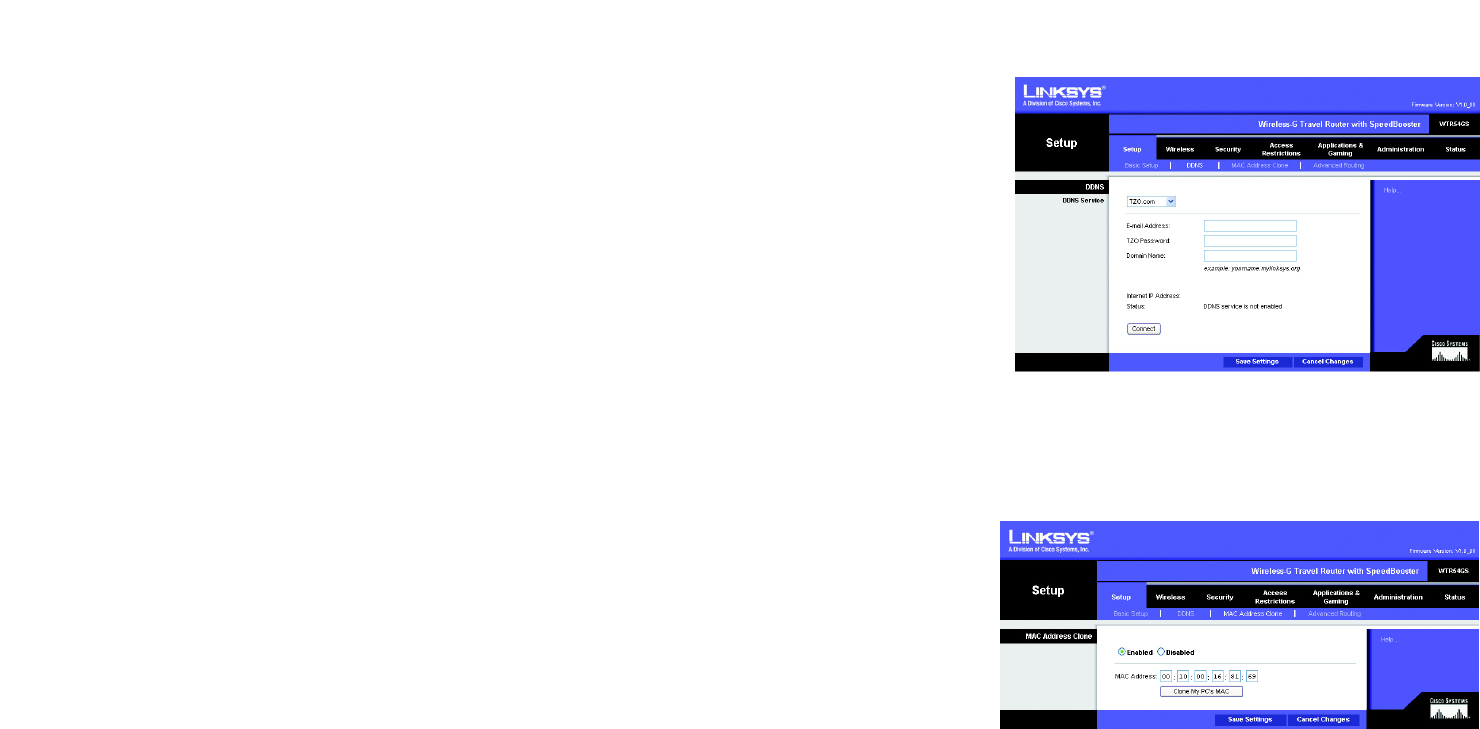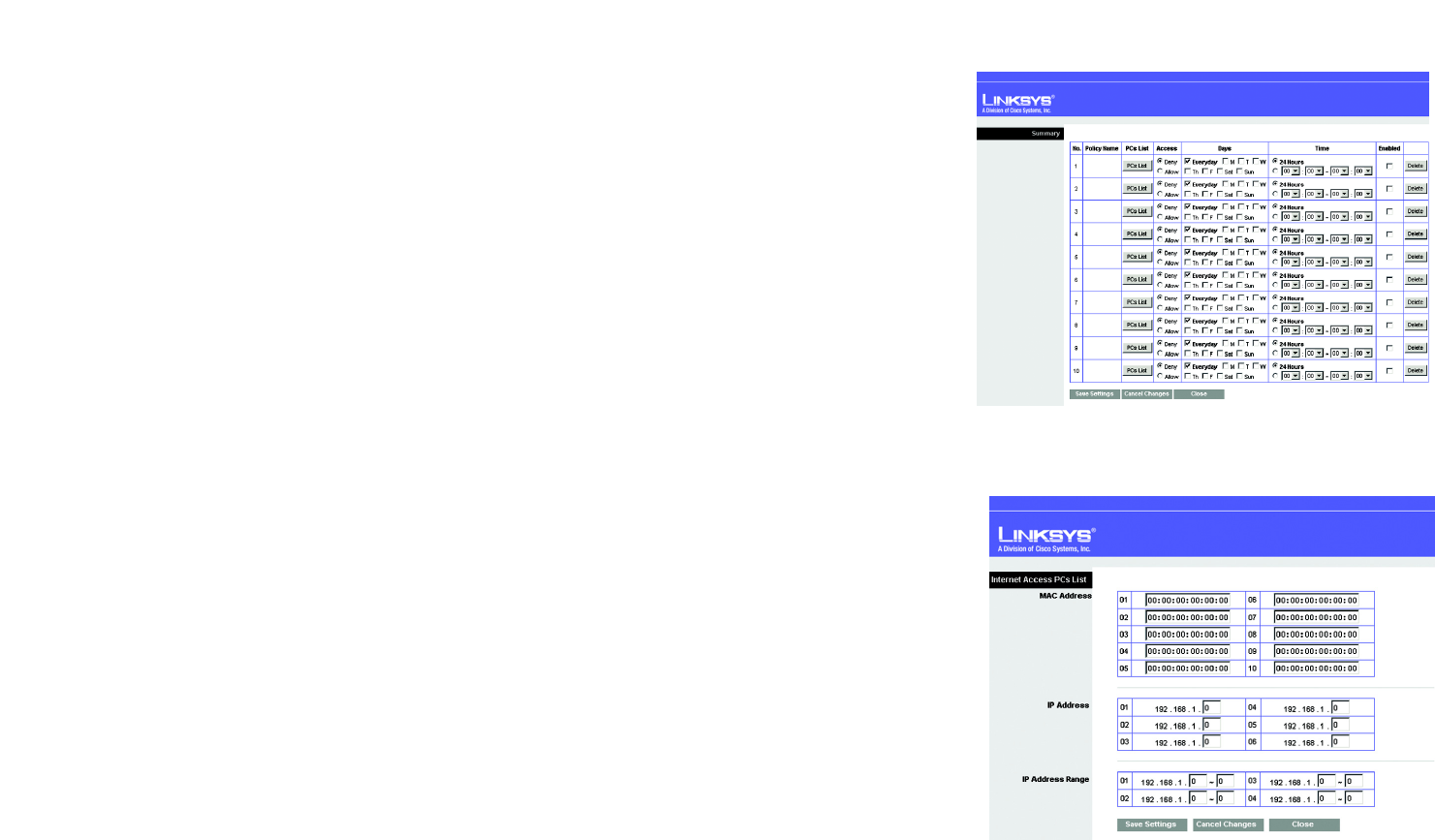LINKSYS WTR54GS Wireless-G Travel Router with SpeedBooster User Manual Book
LINKSYS LLC Wireless-G Travel Router with SpeedBooster Book
LINKSYS >
Contents
- 1. Users Manual 1
- 2. Users Manual 2
- 3. Users Manual 3
Users Manual 2

15
Chapter 5: Configuring the Wireless-G Travel Router with SpeedBooster
The Setup Tab - Basic Setup
Wireless-G Travel Router with SpeedBooster
Router IP
IP Address and Subnet Mask. This shows both the Router’s IP Address and Subnet Mask, as seen by your
network. The default IP Address is 192.168.16.1, and the default Subnet Mask is 255.255.255.0. In most cases,
keeping the default values will work.
DHCP Server Setting
The settings allow you to configure the Router’s Dynamic Host Configuration Protocol (DHCP) server function. The
Router can be used as a DHCP server for your network. A DHCP server automatically assigns an IP address to
each computer on your network. If you choose to enable the Router’s DHCP server option, you must make sure
there is no other DHCP server on your network.
DHCP Server. DHCP is enabled by factory default. If you already have a DHCP server on your network, or you
don’t want a DHCP server, then select Disabled (no other DHCP features will be available).
Static DHCP. Every time a PC reboots, it is assigned a new local IP address by the Router. If you want a PC to be
assigned the same IP address every time it reboots, then click the Static IP button.
On the DHCP Client List screen, enter the static local IP address in the Assign this IP field, and enter the MAC
address of the PC in the To this MAC field. Then click the Enabled checkbox. When you have finished your entries,
click the Save Settings button to save your changes. Click the Cancel Changes button to cancel your changes.
To exit this screen, click the Close button.
If you want to see a list of DHCP clients, click the DHCP Client Table button. On the DHCP Client Table screen, you
will see a list of DHCP clients with the following information: Client Name, Interface, IP Addresse, and MAC
Addresse. To save the information, select Static DHCP Client List. From the To Sort by drop-down menu, you can
sort the table by Client Name, Interface, IP Address, or MAC Address. To view the most up-to-date information,
click the Refresh button. To exit this screen, click the Close button.
Start IP Address. Enter a value for the DHCP server to start with when issuing IP addresses. Because the
Router’s default IP address is 192.168.16.1, the Starting IP Address must be 192.168.1.2 or greater, but smaller
than 192.168.1.254. The default Starting IP Address is 192.168.16.100.
Maximum Number of Users. Enter the maximum number of PCs that you want the DHCP server to assign IP
addresses to. This number cannot be greater than 253. The default is 50.
IP Address Range. The range of DHCP addresses is displayed here.
Client Lease Time. The Client Lease Time is the amount of time a network user will be allowed connection to the
Router with their current dynamic IP address. Enter the amount of time, in minutes, that the user will be “leased”
Figure 5-9: Static DHCP Client List
Figure 5-10: DHCP Client Table

16
Chapter 5: Configuring the Wireless-G Travel Router with SpeedBooster
The Setup Tab - DDNS
Wireless-G Travel Router with SpeedBooster
this dynamic IP address. After the time is up, the user will be automatically assigned a new dynamic IP address.
The default is 0 minutes, which means one day.
Static DNS (1-3). Your ISP will provide you with at least one DNS (Domain Name System) Server IP Address.
WINS. The Windows Internet Naming Service (WINS) manages each PC’s interaction with the Internet. If you use
a WINS server, enter that server’s IP Address here. Otherwise, leave this blank.
Time Settings
Change the time zone in which your network functions from this pull-down menu. Click the checkbox if you want
the Router to automatically adjust for daylight savings time.
Change these settings as described here and click the Save Settings button to apply your changes or Cancel
Changes to cancel your changes. Help information is shown on the right-hand side of the screen.
The Setup Tab - DDNS
The Router offers a Dynamic Domain Name System (DDNS) feature. DDNS lets you assign a fixed host and domain
name to a dynamic Internet IP address. It is useful when you are hosting your own website, FTP server, or other
server behind the Router.
Before you can use this feature, you need to sign up for DDNS service at one of two DDNS service providers, DynDNS.org or
TZO.com. If you do not want to use this feature, keep the default setting, Disabled.
DDNS
DDNS Service. If your DDNS service is provided by DynDNS.org, then select DynDNS.org from the drop-down
menu. If your DDNS service is provided by TZO, then select TZO.com. The features available on the DDNS screen
will vary, depending on which DDNS service provider you use.
DynDNS.org
User Name, Password, and Host Name. Enter the User Name, Password, and Host Name of the account you
set up with DynDNS.org.
Internet IP Address. The Router’s current Internet IP Address is displayed here. Because it is dynamic, it will
change.
Status. The status of the DDNS service connection is displayed here.
dynamic ip address: a temporary IP
address assigned by a DHCP server.
Figure 5-11: DynDNS.org

17
Chapter 5: Configuring the Wireless-G Travel Router with SpeedBooster
The Setup Tab - MAC Address Clone
Wireless-G Travel Router with SpeedBooster
TZO.com
E-mail Address, TZO Password, and Domain Name. Enter the Email Address, Password, and Domain Name
of the service you set up with TZO.
Internet IP Address. The Router’s current Internet IP Address is displayed here. Because it is dynamic, this
will change.
Status. The status of the DDNS service connection is displayed here.
When you have finished making changes to this screen, click the Save Settings button to apply your changes or
Cancel Changes to cancel your changes. Help information is shown on the right-hand side of the screen.
The Setup Tab - MAC Address Clone
A MAC address is a 12-digit code assigned to a unique piece of hardware for identification. Some ISPs will
require you to register a MAC address in order to access the Internet. If you do not wish to re-register the MAC
address with your ISP, you may assign the MAC address you have currently registered with your ISP to the Router
with the MAC Address Clone feature.
MAC Address Clone
Enabled/Disabled. To have the MAC Address cloned, select Enabled from the drop-down menu.
MAC Address. Enter the MAC Address registered with your ISP here.
Clone My PC’s MAC. Clicking this button will clone the MAC address of the PC you are currently using.
Change these settings as described here and click the Save Settings button to apply your changes or Cancel
Changes to cancel your changes. Help information is shown on the right-hand side of the screen.
Figure 5-13: Setup Tab - MAC Address Clone
mac address: the unique address that a
manufacturer assigns to each networking device.
Figure 5-12: TZO.com

18
Chapter 5: Configuring the Wireless-G Travel Router with SpeedBooster
The Setup Tab - Advanced Routing
Wireless-G Travel Router with SpeedBooster
The Setup Tab - Advanced Routing
This tab is used to set up the Router’s advanced functions. Operating Mode allows you to select the type(s) of
advanced functions you use. Dynamic Routing will automatically adjust how packets travel on your network. Static
Routing sets up a fixed route to another network destination.
NAT (Network Address Translation). NAT technology translates IP addresses of a local area network to a
different IP address for the Internet. To enable NAT, click Enabled. To disable NAT, click Disabled.
Dynamic Routing (RIP)
. This feature enables the Router to automatically adjust to physical changes in the
network’s layout and exchange routing tables with the other router(s). The Router determines the network packets’
route based on the fewest number of hops between the source and the destination. This feature is
Disabled
by
default.
Static Routing
. A static route is a pre-determined pathway that network information must travel to reach a specific
host or network. To set up a static route between the Router and another network, enter the information described
below to set up a new static route by clicking the
Add New Entry
button to add an entry. Click the
Update Selected
Entry
button to change an existing entry. (Click the
Delete
button to delete a static route.)
Destination LAN IP
. The Destination LAN IP is the address of the remote network or host to which you want to
assign a static route.
Enter the IP address of the host for which you wish to create a static route. If you are
building a route to an entire network, be sure that the network portion of the IP address is set to 0. For
example, the Router’s standard IP address is 192.168.16.1. Based on this address, the address of the routed
network is 192.168.16, with the last digit determining the Router’s place on the network. Therefore you would
enter the IP address 192.168.16.0 if you wanted to route to the Router’s entire network, rather than just to the
Router.
Subnet Mask
. The Subnet Mask determines which portion of a Destination LAN IP address is the network
portion, and which portion is the host portion.
For example, a network may have the Subnet Mask of
255.255.255.0. This determines (by using the values 255) that the first three numbers of a network IP address
identify this particular network, while the last digit (from 1 to 254) identifies the specific host.
Default Gateway
. This is the IP address of the gateway device that allows for contact between the Router and
the remote network or host.
Interface
. This interface tells you whether the Destination IP Address is on the
LAN & Wireless
(Ethernet and
wireless networks) or the
Internet
(WAN). From the drop-down menu, you can also select
LAN & Wireless
, which
performs dynamic routing over your Ethernet and wireless networks. You can also select
WAN
, which performs
dynamic routing with data coming from the Internet. Finally, selecting
Both
enables dynamic routing for both
networks, as well as data from the Internet.
Figure 5-14: Setup Tab - Advanced Routing
Figure 5-15: Setup Tab - Advanced Routing - Routing
Table

19
Chapter 5: Configuring the Wireless-G Travel Router with SpeedBooster
The Wireless Tab - Basic Wireless Settings
Wireless-G Travel Router with SpeedBooster
Metric. This determines the maximum number of steps between network nodes that data packets will travel.
A node is any device on the network, such as PCs, print servers, routers, etc.
Click the
Show Routing Table
button to view the Static Routes you’ve already set up.
Show Routing Table. For
each route, the Destination (LAN IP address), (Subnet) Mask, (Default) Gateway, and Metric are displayed. Click
the Refresh button to update the information. Click the Close button to close the table.
Change these settings as described here and click the
Save Settings
button to apply your changes or
Cancel
Changes
to cancel your changes.
The Wireless Tab - Basic Wireless Settings
The basic settings for wireless networking are set on this screen.
Basic Wireless Settings
Wireless. To use your Router’s wireless connection, click Enabled. To disable your connection, click Disabled.
Network Mode. From this drop-down menu, you can select the wireless standards running on your network. If
you have both 802.11g and 802.11b devices in your network, keep the default setting, Mixed. If you have only
802.11g devices, select Wireless-G Only. If you have only 802.11b devices, select Wireless-B Only.
Network Name (SSID). The SSID is the network name shared by all devices in a wireless network. The SSID
must be identical for all devices in the wireless network. It is case-sensitive and must not exceed 32 keyboard
characters in length. Make sure this setting is the same for all devices in your wireless network. For added
security, you should change the default SSID (linksys) to a unique name.
Channel. Select the appropriate channel from the list provided to correspond with your network settings. All
devices in your wireless network must broadcast on the same channel in order to communicate.
SSID Broadcast. When wireless clients survey the local area for wireless networks to associate with, they will
detect the SSID broadcast by the Router. To broadcast the Router's SSID, keep the default setting, Enabled. If you
do not want to broadcast the Router's SSID, then select Disabled.
Encryption. The wireless security used on your wireless network is displayed here.
Figure 5-16: Wireless Tab - Basic Wireless Settings

20
Chapter 5: Configuring the Wireless-G Travel Router with SpeedBooster
The Wireless Tab - Basic Wireless Settings
Wireless-G Travel Router with SpeedBooster
SecureEasySetup Button. The status of the Router’s SecureEasySetup feature is displayed here. If you want to
use the SecureEasySetup feature, click the SecureEasySetup button.
You will be asked to press the SecureEasySetup button (hardware or software) on your wireless client (computer
or other network device) within two minutes to complete the SecureEasySetup process. Click the OK button to
continue.
A new screen will be displayed while the Router is waiting for you to push the SecureEasySetup button on your
wireless client.
When the SecureEasySetup process is complete, the Basic Wireless Settings screen will appear, and the Current
Encryption and Status information will be updated.
Status. The status of your wireless security is displayed here.
Reset Security. If you already set up the network using the SecureEasySetup feature and you want to replace
your current settings with new SecureEasySetup settings, click the Reset Security button. A new screen will
appear. You will be asked to confirm that you want to reset your wireless security settings. Click the OK button to
continue.
The Router will generate a new network name (SSID) and set of keys.
Change these settings as described here and click the Save Settings button to apply your changes or Cancel
Changes to cancel your changes. Help information is shown on the right-hand side of the screen.

21
Chapter 5: Configuring the Wireless-G Travel Router with SpeedBooster
The Wireless Tab - Wireless Security
Wireless-G Travel Router with SpeedBooster
The Wireless Tab - Wireless Security
The Wireless Security settings configure the security of your wireless network. There are three wireless security
mode options supported by the Router: WPA Personal, WPA2-Personal, WPA2-Mixed, and WEP. (WEP stands for
Wired Equivalent Privacy). These four are briefly discussed here. For detailed instructions on configuring wireless
security for the Router, turn to “Appendix B: Wireless Security.”
When finished making your changes on this tab, click the Save Settings button to save these changes, or click
the Cancel Changes button to undo your changes.
Wireless Security
WEP. WEP is a basic encryption method. Select a level of WEP encryption, 40/64-bit Hex digits or 128-bit Hex
digits. If you want to use a Passphrase, then enter it in the Passphrase field and click the Generate button. If you
want to enter the WEP key manually, then enter it in the WEP Key 1-4 field(s). To indicate which WEP key to use,
select the appropriate TX Key number.
• Passphrase. Instead of manually entering WEP keys, you can enter a passphrase. It is used to generate one or
more WEP keys. It is case-sensitive and should not be longer than 32 alphanumeric characters. (This
Passphrase function is compatible with Linksys wireless products only. If you want to communicate with non-
Linksys wireless products, make a note of the WEP key generated in the Key 1 field, and enter it manually in
the wireless client.) After you enter the Passphrase, click the Generate button to create WEP keys.
• TX Key Select which WEP key (1-4) will be used when the Router sends data. Make sure that the receiving
device (wireless client) is using the same key.
• WEP Keys 1-4. WEP keys enable you to create an encryption scheme for wireless network transmissions. If
you are not using a Passphrase, then manually enter a set of values. (Do not leave a key field blank, and do
not enter all zeroes; they are not valid key values.) If you are using 64-bit WEP encryption, the key must be
exactly 10 hexadecimal characters in length. If you are using 128-bit WEP encryption, the key must be exactly
26 hexadecimal characters in length. Valid hexadecimal characters are “0”-“9” and “A”-“F”.
WPA-Personal. This method offers two encryption methods, TKIP and AES, with dynamic encryption keys. Select
the type of encryption method you want to use, TKIP or AES. Enter the Passphrase, which can have 8 to 63
characters. Then enter the Key Renewal period, which instructs the Router how often it should change the
encryption keys.
Figure 5-17: Wireless Tab - Wireless Security
(WEP)
Figure 5-18: Wireless Tab - Wireless Security
(WPA Personal)
wep (wired equivalent privacy): a method of
encrypting network data transmitted on a
wireless network for greater security.
IMPORTANT: If you are using encryption,
always remember that each device in your
wireless network MUST use the same
encryption method and encryption key, or
else your wireless network will not function
properly.

22
Chapter 5: Configuring the Wireless-G Travel Router with SpeedBooster
The Wireless Tab - Wireless Security
Wireless-G Travel Router with SpeedBooster
Figure 5-20: Wireless Tab - Wireless Security (WPA2-Mixed)
WPA2-Personal. WPA2-Personal gives you one encryption method, AES, with dynamic encryption keys. Enter a
Passphrase of 8-63 characters. Then enter a Key Renewal period, which instructs the Router how often it should
change the encryption keys.
WPA2-Mixed. WPA2-Mixed gives you TKIP+AES encryption. Enter a Passphrase of 8-63 characters. Then enter a
Key Renewal period, which instructs the Router how often it should change the encryption keys.
Figure 5-19: Wireless Tab - Wireless Security
(WPA2-Personal)

23
Chapter 5: Configuring the Wireless-G Travel Router with SpeedBooster
The Wireless Tab - Wireless MAC Filter
Wireless-G Travel Router with SpeedBooster
The Wireless Tab - Wireless MAC Filter
Wireless access can be filtered by using the MAC addresses of the wireless devices transmitting within your
network’s radius.
Wireless MAC Filter
To filter wireless users by MAC Address, either permitting or blocking access, click Enabled. If you do not wish to
filter users by MAC Address, select Disabled.
Access Restriction
Prevent ONLY PCs listed below to access the wireless network. Clicking this radio button will block wireless
access by MAC Address.
Permit ONLY PCs listed below to access the wireless network. Clicking this radio button will allow wireless
access by MAC Address.
Wireless Client List
Wireless Client List. Click the Wireless Client MAC List button to display a list of network users by MAC
Address. From the To Sort by drop-down menu, you can sort the table by Client Name, IP Address, MAC Address,
or Expires. To view the most up-to-date information, click the Refresh button. To exit this screen, click the Close
button.
Change these settings as described here and click the Save Settings button to apply your changes or Cancel
Changes to cancel your changes. Help information is shown on the right-hand side of the screen.
Figure 5-21: Wireless Tab - Wireless MAC Filter
Figure 5-22: Wireless Tab - Wireless Client List

24
Chapter 5: Configuring the Wireless-G Travel Router with SpeedBooster
The Wireless Tab - Advanced Wireless Settings
Wireless-G Travel Router with SpeedBooster
The Wireless Tab - Advanced Wireless Settings
This tab is used to set up the Router’s advanced wireless functions. These settings should only be adjusted by an
expert administrator as incorrect settings can reduce wireless performance.
Advanced Wireless
Frame Burst Mode. Enabling this option should provide your network with greater performance, depending on
the manufacturer of your wireless products. If you are not sure how to use this option, keep the default, Enabled
(Default).
AP Isolation. This isolates all wireless clients and wireless devices on your network from each other. Wireless
devices will be able to communicate with the Router but not with each other. To use this function, click Enabled.
AP Isolation is disabled by default.
Authentication Type. The default is set to Open System, allows either Open System or Shared Key
authentication to be used. With Open System authentication, the sender and the recipient do NOT use a WEP key
for authentication. With Shared Key authentication, the sender and recipient use a WEP key for authentication.
Basic Rate. The Basic Rate setting is not actually one rate of transmission but a series of rates at which the
Router can transmit. The Router will advertise its Basic Rate to the other wireless devices in your network, so
they know which rates will be used. The Router will also advertise that it will automatically select the best rate
for transmission. The default setting is Default, when the Router can transmit at all standard wireless rates
(1-2Mbps, 5.5Mbps, 11Mbps, 18Mbps, and 24Mbps). Other options are 1-2Mbps, for use with older wireless
technology, and All, when the Router can transmit at all wireless rates. The Basic Rate is not the actual rate of
data transmission. If you want to specify the Router’s rate of data transmission, configure the Transmission Rate
setting.
Transmission Rate. The rate of data transmission should be set depending on the speed of your wireless
network. You can select from a range of transmission speeds, or you can select Auto (Default) to have the
Router automatically use the fastest possible data rate and enable the Auto-Fallback feature. Auto-Fallback will
negotiate the best possible connection speed between the Router and a wireless client. The default value is Auto
(Default).
CTS Protection Mode. CTS (Clear-To-Send) Protection Mode should be set to Auto (Default). The Router will
automatically use CTS Protection Mode when your Wireless-G products are experiencing severe problems and
are not able to transmit to the Router in an environment with heavy 802.11b traffic. This function boosts the
Router’s ability to catch all Wireless-G transmissions but will severely decrease performance.
Beacon Interval. The default value is 100. The Beacon Interval value indicates the frequency interval of the
beacon. A beacon is a packet broadcast by the Router to synchronize the wireless network.
Figure 5-23: Wireless Tab - Advanced Wireless
Settings
cts (clear to send): a signal sent by a wireless
device, signifying that it is ready to receive data.
dtim: a message included in data packets
that can increase wireless efficiency.

25
Chapter 5: Configuring the Wireless-G Travel Router with SpeedBooster
The Wireless Tab - Advanced Wireless Settings
Wireless-G Travel Router with SpeedBooster
DTIM Interval. This value indicates the interval of the Delivery Traffic Indication Message (DTIM). A DTIM field is
a countdown field informing clients of the next window for listening to broadcast and multicast messages. When
the Router has buffered broadcast or multicast messages for associated clients, it sends the next DTIM with a
DTIM Interval value. Its clients hear the beacons and awaken to receive the broadcast and multicast messages.
The default value is 1.
Fragmentation Threshold. This value specifies the maximum size for a packet before data is fragmented into
multiple packets. If you experience a high packet error rate, you may slightly increase the Fragmentation
Threshold. Setting the Fragmentation Threshold too low may result in poor network performance. Only minor
reduction of the default value is recommended. In most cases, it should remain at its default value of 2346.
RTS Threshold. Should you encounter inconsistent data flow, only minor reduction of the default value, 2347, is
recommended. If a network packet is smaller than the preset RTS threshold size, the RTS/CTS mechanism will
not be enabled. The Router sends Request to Send (RTS) frames to a particular receiving station and negotiates
the sending of a data frame. After receiving an RTS, the wireless station responds with a Clear to Send (CTS)
frame to acknowledge the right to begin transmission. The RTS Threshold value should remain at its default value
of 2347.
Change these settings as described here and click the Save Settings button to apply your changes or Cancel
Changes to cancel your changes. Help information is shown on the right-hand side of the screen.
beacon interval: data transmitted on your wireless
network that keeps the network synchronized.
fragmentation: breaking a packet into smaller units
when transmitting over a network medium that
cannot support the original size of the packet.

26
Chapter 5: Configuring the Wireless-G Travel Router with SpeedBooster
The Security Tab - Firewall
Wireless-G Travel Router with SpeedBooster
The Security Tab - Firewall
The Firewall screen offers Filters and the option to Block WAN Requests. Filters block specific Internet data types
and block anonymous Internet requests. To enable a feature, select Enabled from the drop-down menu. To
disable a feature, select Disabled from the drop-down menu.
Firewall
• SPI Firewall Protection. Enable this feature to employ Stateful Packet Inspection (SPI) for more detailed
review of data packets entering your network environment.
• Filter Anonymous Internet Requests. When enabled, this feature keeps your network from being “pinged,” or
detected, by other Internet users. It also reinforces your network security by hiding your network ports. Both
functions of this feature make it more difficult for outside users to work their way into your network. This
feature is enabled by default. Select Disabled to allow anonymous Internet requests.
• Filter Multicast. Multicasting allows for multiple transmissions to specific recipients at the same time. If
multicasting is permitted, then the Router will allow IP multicast packets to be forwarded to the appropriate
computers. Select Enable to filter multicasting, or Disable to disable this feature.
• Filter Internet NAT Redirection. This feature uses port forwarding to block access to local servers from local
networked computers. Check the box to enable filter Internet NAT redirection, or uncheck the box to disable
this feature.
• Web Filters
Proxy. Use of WAN proxy servers may compromise the Gateway's security. Denying Filter Proxy will disable
access to any WAN proxy servers. To enable proxy filtering, click the checkbox.
Java. Java is a programming language for websites. If you deny Java, you run the risk of not having access to
Internet sites created using this programming language. To enable Java filtering, click the checkbox.
ActiveX. ActiveX is a programming language for websites. If you deny ActiveX, you run the risk of not having
access to Internet sites created using this programming language. To enable ActiveX filtering, click the
checkbox.
Cookies. A cookie is data stored on your computer and used by Internet sites when you interact with them. To
enable cookie filtering, click the checkbox.
Change these settings as described here and click the Save Settings button to apply your changes or Cancel
Changes to cancel your changes. Help information is shown on the right-hand side of the screen.
Figure 5-24: Security Tab - Firewall

27
Chapter 5: Configuring the Wireless-G Travel Router with SpeedBooster
The Security Tab - VPN Passthrough
Wireless-G Travel Router with SpeedBooster
The Security Tab - VPN Passthrough
Use the settings on this tab to allow VPN tunnels using IPSec, L2TP, or PPTP protocols to pass through the
Router’s firewall.
VPN Passthrough
IPSec Passthrough. Internet Protocol Security (IPSec) is a suite of protocols used to implement secure exchange
of packets at the IP layer. IPSec Pass-Through is enabled by default. To disable IPSec Passthrough, select
Disabled.
L2TP Passthrough. Layer 2 Tunneling Protocol is the method used to enable Point-to-Point sessions via the
Internet on the Layer 2 level. L2TP Pass-Through is enabled by default. To disable L2TP Passthrough, select
Disabled.
PPTP Passthrough. Point-to-Point Tunneling Protocol (PPTP) allows the Point-to-Point Protocol (PPP) to be
tunneled through an IP network. PPTP Pass-Through is enabled by default. To disable PPTP Passthrough, select
Disabled.
Change these settings as described here and click the Save Settings button to apply your changes or Cancel
Changes to cancel your changes. Help information is shown on the right-hand side of the screen.
The Security Tab - VPN
Use the settings on this tab to create VPN tunnels. The Wireless-G Travel Router creates a tunnel or channel
between two endpoints, so that the data or information between these endpoints is secure.
VPN Tunnel
Establishing a Tunnel
The Router creates a tunnel or channel between two endpoints, so that the data or information between these
endpoints is secure. To establish this tunnel, select the tunnel you wish to create in the Select Tunnel Entry drop-
down menu. It is possible to create up to two simultaneous tunnels. To delete a tunnel, click the Delete button.
To view a summary of that tunnel, click the Summary button. The VPN Settings Summary screen displays the
number, name, local group, remote group, remote gateway, and security method.
Then check the box next to Enable to enable the tunnel. Once the tunnel is enabled, enter the name of the tunnel
in the Tunnel Name field. This is to allow you to identify multiple tunnels and does not have to match the name
used at the other end of the tunnel.
ipsec: a VPN protocol used to implement
secure exchange of packets at the IP layer.
pptp: a VPN protocol that allows the Point to Point
Protocol (PPP) to be tunneled through an IP network.
This protocol is also used as a type of broadband
connection in Europe.
Figure 5-25: Security Tab - VPN Passthrough
Figure 5-26: Security Tab - VPN

28
Chapter 5: Configuring the Wireless-G Travel Router with SpeedBooster
The Security Tab - VPN
Wireless-G Travel Router with SpeedBooster
Local Secure Group and Remote Secure Group
A Local Secure Group is a computer(s) on your network that can access the tunnel. A Remote Secure Group is a
computer (s) on the remote end of the tunnel that can access the tunnel. Under Local Secure Group and Remote
Secure Group, you may choose one of three options: Subnet, IP Address, and IP Range. Under Remote Secure
Group, you have two additional options: Host and Any.
Subnet. If you select Subnet (which is also the default), this will allow all computers on the local subnet to
access the tunnel. When using the Subnet setting, the default values of 0 should remain in the last fields of
the IP and Mask settings.
IP Address. If you select IP Address, only the computer with the specific IP Address that you enter will be
able to access the tunnel.
IP Range. If you select IP Range, it will be a combination of Subnet and IP Address. You can specify a range
of IP Addresses within the Subnet which will have access to the tunnel.
The next to options are for Remote Secure Groups only.
Host. If you select Host for the Remote Secure Group, then the Remote Secure Group will be the same as the
Remote Security Gateway setting: IP Address, FQDN (Fully Qualified Domain Name), or Any.
Any. If you select Any for the Remote Security Group, the local VPN Router will accept a request from any IP
address. This setting should be chosen when the other endpoint is using DHCP or PPPoE on the Internet side.
Remote Security Gateway
The Remote Security Gateway is the VPN device, such as a second VPN Router, on the remote end of the VPN
tunnel. Under Remote Security Gateway, you have three options: IP Address, FQDN, and Any. In this section, you
can also set the levels and types of encryption and authentication.
IP Address. If you select IP Address, enter the IP Address of the VPN device at the other end of the tunnel.
The remote VPN device can be another VPN Router, a VPN Server, or a computer with VPN client software that
supports IPSec. The IP Address may either be static (permanent) or dynamic (changing), depending on the
settings of the remote VPN device. Make sure that you have entered the IP Address correctly, or the
connection cannot be made. Remember, this is NOT the IP Address of the local VPN Router, but the IP Address
of the remote VPN Router or device with which you wish to communicate.
FQDN (Fully Qualified Domain Name). If you select FQDN, enter the FQDN of the VPN device at the other end of
the tunnel. The remote VPN device can be another VPN Router, a VPN Server, or a computer with VPN client
software that supports IPSec. The FQDN is the host name and domain name for a specific computer on the
Internet, for example, vpn.myvpnserver.com.
Figure 5-27: Security Tab - VPN - Summary

29
Chapter 5: Configuring the Wireless-G Travel Router with SpeedBooster
The Security Tab - VPN
Wireless-G Travel Router with SpeedBooster
Any. If you select Any for the Remote Security Gateway, the VPN device at the other end of the tunnel will
accept a request from any IP address. The remote VPN device can be another VPN Router, a VPN Server, or a
computer with VPN client software that supports IPSec. If the remote user has an unknown or dynamic IP
address (such as a professional on the road or a telecommuter using DHCP or PPPoE), then Any should be
selected.
Encryption. Using Encryption also helps make your connection more secure. There are two different types of
encryption: DES or 3DES (3DES is recommended because it is more secure). You may choose either of these,
but it must be the same type of encryption that is being used by the VPN device at the other end of the tunnel.
Or, you may choose not to encrypt by selecting Disable.
Authentication. Authentication acts as another level of security. There are two types of authentication: MD5
and SHA (SHA is recommended because it is more secure). As with encryption, either of these may be
selected, provided that the VPN device at the other end of the tunnel is using the same type of authentication.
Or, both ends of the tunnel may choose to Disable authentication.
Key Management
In order for any encryption to occur, the two ends of the tunnel must agree on the type of encryption and the way
the data will be decrypted. This is done by sharing a “key” to the encryption code. Under Key Management, you
may choose automatic or manual key management.
Automatic Key Management. Select Auto (IKE) and enter a series of numbers or letters in the Pre-shared
Key field. Check the box next to PFS (Perfect Forward Secrecy) to ensure that the initial key exchange and IKE
proposals are secure. In the example shown the word chappy is used. Based on this word, which MUST be
entered at both ends of the tunnel if this method is used, a key is generated to scramble (encrypt) the data
being transmitted over the tunnel, where it is unscrambled (decrypted). You may use any combination of up
to 24 numbers or letters in this field. No special characters or spaces are allowed. In the Key Lifetime field,
you may optionally select to have the key expire at the end of a time period of your choosing. Enter the
number of seconds you’d like the key to be useful, or leave it blank for the key to last indefinitely.
Manual Key Management. Similarly, you may choose Manual keying, which allows you to generate the key
yourself. Enter your key into the Encryption KEY field. Then enter an Authentication KEY into that field. These
fields must both match the information that is being entered in the fields at the other end of the tunnel. Up to
24 alphanumeric characters are allowed to create the Encryption Key. Up to 20 alphanumeric characters are
allowed to create the Authentication Key.
The Inbound SPI and Outbound SPI fields are different, however. The Inbound SPI value set here must match
the Outbound SPI value at the other end of the tunnel. The Outbound SPI here must match the Inbound SPI
value at the other end of the tunnel. That is, the Inbound SPI and Outbound SPI values would be opposite on
the other end of the tunnel. Only numbers can be used in these fields. After you click the Save Settings

30
Chapter 5: Configuring the Wireless-G Travel Router with SpeedBooster
The Security Tab - VPN
Wireless-G Travel Router with SpeedBooster
button, hexadecimal characters (series of letters and numbers) are displayed in the Inbound SPI and
Outbound SPI fields.
The Status field at the bottom of the screen will show when a tunnel is active.
To connect a VPN tunnel, click the Connect button. The View Logs button, when logging is enabled on the Log
screen of the Administration tab, will show you VPN activity on a separate screen. The VPN Log screen displays
successful connections, transmissions and receptions, and the types of encryption used. For more advanced VPN
options, click the Advanced Setting button to open the Advanced Setting screen.
When finished making your changes on this screen, click the Save Settings button to save these changes, or
click the Cancel Changes button to undo your changes.
Advanced VPN Tunnel Setup
From the Advanced Settings screen you can adjust the settings for specific VPN tunnels.
Phase 1
. Phase 1 is used to create a security association (SA), often called the IKE SA. After Phase 1 is completed, Phase
2 is used to create one or more IPSec SAs, which are then used to key IPSec sessions.
Operation Mode
. There are two modes: Main and Aggressive, and they exchange the same IKE payloads in different
sequences. Main mode is more common; however, some people prefer Aggressive mode because it is faster. Main mode
is for normal usage and includes more authentication requirements than Aggressive mode. Main mode is recommended
because it is more secure. No matter which mode is selected, the VPN Router will accept both Main and Aggressive
requests from the remote VPN device. If a user on one side of the tunnel is using a Unique Firewall Identifier, this should
be entered under the
Username
field.
Encryption
. Select the length of the key used to encrypt/decrypt ESP packets. There are two choices: DES and 3DES.
3DES is recommended because it is more secure.
Authentication
. Select the method used to authenticate ESP packets. There are two choices: MD5 and SHA. SHA is
recommended because it is more secure.
Group
. There are two Diffie-Hellman Groups to choose from: 768-bit and 1024-bit. Diffie-Hellman refers to a
cryptographic technique that uses public and private keys for encryption and decryption.
Key Lifetime
. In the Key Lifetime field, you may optionally select to have the key expire at the end of a time period of your
choosing. Enter the number of seconds you’d like the key to be used until a re-key negotiation between each endpoint is
completed.
Phase 2
Group
. There are two Diffie-Hellman Groups to choose from: 768-bit and 1024-bit. Diffie-Hellman refers to a
cryptographic technique that uses public and private keys for encryption and decryption.
Figure 5-28: Security Tab - VPN - Advanced VPN Tunnel
Setup

31
Chapter 5: Configuring the Wireless-G Travel Router with SpeedBooster
The Access Restrictions Tab - Internet Access Policy
Wireless-G Travel Router with SpeedBooster
Key Lifetime
. In the Key Lifetime field, you may optionally select to have the key expire at the end of a time period of your
choosing. Enter the number of seconds you’d like the key to be used until a re-key negotiation between each endpoint is
completed.
The Access Restrictions Tab - Internet Access Policy
The Internet Access Policy screen allows you to block or allow specific kinds of Internet usage and traffic, such as
Internet access, designated applications, websites, and inbound traffic during specific days and times.
Internet Access Policy
Access Policy. Access can be managed by a policy. Use the settings on this screen to establish an access policy
(after the Save Settings button is clicked). Selecting a policy from the drop-down menu will display that policy’s
settings. To delete a policy, select that policy’s number and click the Delete This Policy button. To view all the
policies, click the Summary button.
On the Summary screen, the policies are listed with the following information: No., Policy Name, Access, Days,
Time, and status (Enabled). You can change the type of access, days, and times of a policy. To activate a policy,
click the Enabled checkbox. To delete a policy, click its Delete button. Click the Save Settings button to save
your changes, or click the Cancel Changes button to cancel your changes. To return to the Internet Access Policy
tab, click the Close button. To view the list of PCs for a specific policy, click the PCs List button.
On the Internet Access PCs List screen, you can select a PC by MAC Address or IP Address. You can also enter a
range of IP Addresses if you want this policy to affect a group of PCs. After making your changes, click the Save
Settings button to apply your changes or Cancel Changes to cancel your changes. Click the Close button to exit
this screen.
To create an Internet Access policy:
1. Select a number from the Access Policy drop-down menu.
2. Enter a Policy Name in the field provided.
3. To enable this policy, select Enable from the Status drop-down menu.
4. Click the Edit List button to select which PCs will be affected by the policy. The Internet Access PCs List
screen will appear. You can select a PC by MAC Address or IP Address. You can also enter a range of IP
Addresses if you want this policy to affect a group of PCs. After making your changes, click the Save Settings
button to apply your changes or Cancel Changes to cancel your changes. Then click the Close button.
Figure 5-29: Access Restrictions Tab - Internet Access
Policy

32
Chapter 5: Configuring the Wireless-G Travel Router with SpeedBooster
The Access Restrictions Tab - Internet Access Policy
Wireless-G Travel Router with SpeedBooster
Figure 5-30: Access Restrictions Tab - Summary
Figure 5-31: Access Restrictions Tab - Internet Access
PCs List
5. Click the appropriate option, Deny or Allow, depending on whether you want to block or allow Internet access
for the PCs you listed on the List of PCs screen.
6. Decide which days and what times you want this policy to be enforced. Select the individual days during
which the policy will be in effect, or select Everyday. Then enter a range of hours and minutes during which
the policy will be in effect, or select 24 Hours.
7. You can filter access to various applications accessed over the Internet, such as FTP or telnet, by selecting up
to three applications from the drop-down menus under Applications.
The Blocked List menu offers a choice of ten preset applications. For the preset applications you select, the
appropriate range of ports will automatically be displayed. Click the >> button to add to the Blocked Services
list.
If the application you want to block is not listed or you want to edit an application’s settings, then create a
new one by entering an Application Name, Port Range, and Protocol. Then, click Add.
8. You can also block access by URL address by entering it in the Website Blocking by URL Address field or by
Keyword by entering it in the Website Blocking by Keyword field.
9. Click the Save Settings button to save the policy’s settings. To cancel the policy’s settings, click the Cancel
Changes button.